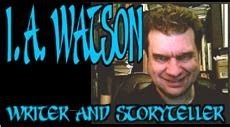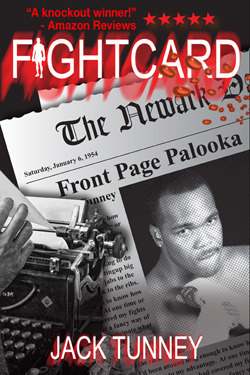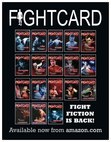Jack Tunney's Blog, page 32
October 31, 2013
FIGHT CARD: FRONT PAGE PALOOKA!
October 30, 2013
AVAILABLE NOW ~ FIGHT CARD: SWAMP WALLOPER!
 AVAILABLE NOW ~ FIGHT CARD: SWAMP WALLOPER!
AVAILABLE NOW ~ FIGHT CARD: SWAMP WALLOPER!PAUL BISHOP (WRITING AS JACK TUNNEY)
THE LONG ANTICIPATED SEQUEL TO THE ORIGINAL FIGHT CARD NOVEL – FIGHT CARD: FELONY FISTS …
PATRICK FELONY FLYNN IS BACK … AND THIS TIME HE’S IN WAY OVER HIS HEAD …
New Orleans, 1956 … When the battered body of boxer Marcus de Trod turns up on the edge of the Bayou Sauvage outside New Orleans with the words ‘Get Felony Flynn LAPD’ tattooed in his armpits, Hat Squad detective, Patrick Felony Flynn, knows he is in for the fight of his life.
Far from the hardboiled streets of Los Angeles, Flynn and his partner, Tombstone Jones, are on a two-fisted rampage to find a killer. But hiding in the swamp, deep inside the walls of the Bayou Sauvage Federal Penitentiary, the killer patiently waits to crush his prey with razor sharp teeth and deadly jaws.
After taking down gangster Mickey Cohen’s championship prospect Solomon Kane in Felony Fists, Patrick Flynn triumphantly returns in Swamp Walloper, facing an even more dangerous foe – a killer fueled by voodoo and revenge …
COMING SOON ~ FIGHT CARD: SWAMP WALLOPER!
New Orleans, 1956
When the battered body of boxer Marcus de Trod turns up on the edge of the Bayou Sauvage outside New Orleans with the words ‘Get Felony Flynn LAPD’ tattooed in his armpits, Hat Squad detective, Patrick Felony Flynn, knows he is in for the fight of his life.
Far from the hardboiled streets of Los Angeles, Flynn and his partner, Tombstone Jones, are on a two-fisted rampage to find a killer. But hiding in the swamp, deep inside the walls of the Bayou Sauvage Federal Penitentiary, the killer patiently waits to crush his prey with razor sharp teeth and deadly jaws.
After taking down gangster Mickey Cohen’s championship prospect Solomon Kane in “Felony Fists,” Patrick Flynn triumphantly returns in “Swamp Walloper,” facing an even more dangerous foe – a killer fueled by voodoo and revenge …
October 29, 2013
MEET FRONT PAGE PALOOKA’S NICK MORETTI!

MEET FRONT PAGE PALOOKA’S NICK MORETTI!
The latest review for Fight Card: Front Page Palooka … “A solid tale of corruption in the prize-fighting game, brought to life with period details, one-liners and slang, boxing lore, historical cameos. Anthony Venutolo gives it to us through the eyes of a whiskey-soaked newspaper man chasing a dream of his own and does so admirably. Here’s hoping he returns for an encore …”
FRONT PAGE PALOOKA
Newark, New Jersey, 1954
Years of fight halls and newsrooms have east coast sportswriter, Nick Moretti, looking for a change. When a sloppy hustle goes bad, and Nick takes a bullet in the shoulder, it’s time to go west. Hired by Pinnacle Pictures to write a boxing movie about troubled heavyweight champ Jericho ‘Rattlesnake’ McNeal, Nick joins forces with sexy public relations gal, Dillian Dawson, for a cross-country tour to give an everyman boxer an unlikely shot at the world title – what could go wrong?
From the crackling neon of Hollywood and Sin City, through the steamy Delta, and on to Chi-Town, the glitzy dream becomes a noir nightmare, and newshound Nick Moretti is about to commit a reporter’s greatest sin – becoming a Front Page Palooka … Another great two-fisted Fight Card tale!
October 28, 2013
COMING IN DECEMBER ~ FIGHT CARD: SHERLOCK HOLMES!
COMING THIS DECEMBER … FIGHT CARD: SHERLOCK HOLMES … THE WORLD’S MOST FAMOUS CONSULTING DETECTIVE GETS READY TO RUMBLE … ANDREW SALMON WRITING AS JACK TUNNEY … PAINTED COVER BY CARL YONDER… LETTERING BY DAVID FOSTER … DON’T MISS THIS ONE …
October 25, 2013
COMING SOON ~ FIGHT CARD NOW: PUNCHING PARADISE
h1 style=”text-align: center;”>
COMING ~ OCTOBER, 2013
FIGHT CARD NOW: PUNCHING PARADISE
Baltimore, 2103
Neckbone is nothing if not a proud fighter. He’ll take a fix if it gives him some extra scratch to help fund the thespian ambitions of his much younger girlfriend, Allison, or buy a six-pack for his ex-con best friend, Rollo. But there isn’t a man or a reason that’ll knock him down if he doesn’t want to go down – and he makes sure everyone knows it.
When Neckbone loses his temper and knocks another fighter down early, he inadvertently throws a young boy into the crosshairs of Bill Stokes, a scheming promoter and aspiring gangster. Now, with everything on the line, Neckbone is in the fight of his life against mobsters, killers, bruisers, and the toughest opponent of all – himself.
Punching Paradise is the first novel in the Fight Card spin-off brand Fight Card Now, featuring contemporary, two-fisted, fight tales with a punch.
Nik Korpon writing as Jack Tunney …
October 18, 2013
PUTTING WRITING FALSEHOODS AGAINST THE ROPES

PUTTING WRITING FALSEHOODS AGAINST THE ROPES
FIGHT CARD ROMANCE: LADIES NIGHT AUTHOR CAROL MALONE (WRITING AS JILL TUNNEY) BLOGS OVER AT THE WRIOTER’S FUN ZONE ABOUT WRITING FALSEHOODS …

Today Writer’s Fun Zone welcomes author Carol Malone (Fight Card Romance: Ladies Night) as she shares with us her writing tips discovered during her writing journey to publishing her first e-book. Don’t start your writing career believing falsehoods: learn the art of writing.
I’ve been on a serious writing journey for awhile and just published my first eBook. While walking that path, I’ve discovered a lot of things about myself and the writing process. Even as an amateur, I’d love to share what I’ve learned in the hopes it will keep someone else’s feet on the trail toward their dreams of successful publishing. I held certain beliefs regarding writing that have proven to be false. Here are my top five …
FOR THE FULL ARTICLE CLICK HERE
October 16, 2013
FRONT PAGE PALOOKA’S SPOTIFY SOUNDTRACK
FRONT PAGE PALOOKA’S SPOTIFY SOUNDTRACK
Fight Card author Anthony Venutolo created the following Spotify soundtrack, which he listen to repeatedly while writing Front Page Palooka …
October 8, 2013
HOW A VINTAGE FIGHT CARD NOVELLA WAS BORN IN THE CLOUD

HOW A VINTANGE FIGHT CARD NOVELLA WAS BORN IN THE CLOUD!
ANTHONY VENUTOLO TELLS US ABOUT THE SURPRISING WRITING TECHNIQUES HE USED WHEN PUNCHING OUT FIGHT CARD: FRONT PAGE PALOOKA …
When Paul Bishop approached me at what now seems like an eternity ago to write a Fight Card entry, I was instantly on board. Fight Card was everything I loved – vintage pulp tales of tough guys and their femme fatales that were hard-boiled and whiskey-soaked. Sign me up.
But then came the panic.
Panic why? Unlike my fellow Fight Card scribes, I wasn’t a novelist. Those said, I was a lifelong journalist and editor by trade and have even dabbled in many other forms of creative writing on the side. Through the years, I’ve written a slew of spec scripts for movies and comic books, a proposal and bible for an animated TV show (which was pitched around) and more magazine and newspaper pieces than I care to remember.
But never a novel …
Sure, I dabbled in short stories, gritty poetry and flash fiction on my blog Bukowski’s Basement, which I know Paul had read. To me, writing the weekly flash fiction noir was easy. Doing that for 30,000 plus words seemed daunting.
What was even more petrifying was the prolific pace that other writers seemed to work. Guys like Bishop, Mel Odem, Eric Beetner, Terrence McCauley and Kevin Michaels all make it look so damned easy.
I needed my wheels to spin like a ’49 Merc.
As far as my Fight Card entry as concerned, I knew one thing, for sure … I didn’t want my hero to be a boxer for the simple reason that the above men wrote their tales so very well. I knew I probably couldn’t top them or tell a story that seemed fresh. As a result, I turned to what I knew – newspapers. For the greater part of a quarter of a century I’ve been working in a newsroom so there was oodles of material I could call upon. Newsrooms seemed like a natural setting for the 1954 time setting of Front Page Palooka. I wanted to draw upon that vibe for my novella. Back when I was hired (as a young cub in the ’80s) men still smoked at their desks and, if they were lucky, had some Sneaky Pete when the sun went down.
I wanted to channel that nostalgia, so I decided to make my hero, Nick Moretti, a grizzled newspaperman. To me, Nick is the conglomeration of several pop culture characters. You might find some Marlowe, some Sonny Crockett, a pinch of Chilli Palmer, a dab of Hank Moody (kudos if you know who he is) and pretty much any Bogie character from 1949-56. That was Nick. He’s sarcastic, has a quick wit, can hold his bourbon and get the girl. Oh, yeah, he can also knuckle up if he needs to.
I had my character. But I still needed a story. I took a breath and before I dove into the writing of Front Page Palooka, and turned to the cloud to foster some creativity.
I created a Pinterest board to help me bask in the glory of Nick Moretti’s world, circa 1954. Pinterest can be of tremendous use for a writer. If you can get beyond the endless photos of cupcakes and kittens, the photo-driven social network is chock full of images you can group onto specific pinboards, all tied to a theme. Talk about inspiration… Who needs index cards, when I could just call up my Meet Nick Moretti pinboard and get an instantaneous handle on the man? I pinned all sorts of photos – stuff Nick would wear, booze he would drink, bars he would frequent, actors who could play him and – most fun – and the endless chippees he’d date. It all started to come together.
To take it one step further, I also turned to Spotify and created a soundtrack of sorts for Front Page Palooka. What exactly is Spotify? It’s a digital streaming service giving users access to millions of songs. It’s free. It’s legal. And it’s allowed me to get that blasted iTunes out of my life. That said, music plays a big part in Palooka, so I wanted the playlist to feel as if a reader were listening to a juke at some dive bar in Nick’s story.
The result? A tremendous and embeddable list of songs that could transport the listener into a bygone era – dance halls in Atlantic City, lavish Hollywood backlots, swanky Vegas casinos, scorched Mississippi plantations, and bourgeois New Orleans saloons. Again, a great way to foster inspiration.
I also wanted to soak up what came before in the hard-boiled and noir arena. I was pleasantly shocked to see a plethora of full-length films available on YouTube and Netflix.
Just a quick sampling of the flicks I was able to stream: Pickup on South Street, Call Northside 777, Sweet Smell of Success, Night and the City, Scandal Sheet, Sunset Blvd., The Strange Love of Martha Ivers, The Black Dahlia, Hollywoodland, Gilda, Tokyo Joe, Deadline USA, Panic in the Streets, House by the River, Woman in the Window, The Stranger, Witness to Murder, Hideout, The Naked City, Union Station, The Man Who Wasn’t There, The Long Goodbye, My Gun is Quick, Kiss Me Deadly, Blonde Ice, While the City Sleeps, Borderline, Kiss of Death, The Prowler, The Night Editor, The Harder They Fall, The Big Caper, The Killing, The Asphalt Jungle, Double Indemnity, Kansas City Confidential, Where the Sidewalk Ends and Detour.
It was time to start writing.
Front Page Palooka (originally titled Union Of The Snakes) was written entirely in the cloud. Sure, a local copy was saved on my main laptop, but whenever I switched computers, it was waiting for me, no matter where I was. My primary service was Skydrive, with a backup on Google Drive and Dropbox. On days when I didn’t feel like lugging out the laptop, the writing was done using the same services on my iPad and a great app called IA Writer.
So, there … That’s how a vintage novella set in 1954 was born and bred using cloud services circa 2013. There are so many tools available for writers today to gain inspiration while putting the words down one after another …
WRITE THE GOOD FIGHT

WRITE THE GOOD FIGHT!
British author I.A. Watson is a prolific adventure writer with his feet firmly planted in the New Pulp genre. His numerous stories published in collections from Pro Se’s Pulp Obscura imprint further the adventures of such pulp stawarts as air ace Richard Knight and adventurer Armless O’Neil, and his three Robin Hood novels published by Airship 27 are a tour-de-force … Today he’s on Bish’s Beat talking about the writing of top-notch fight scenes – a subject near to the heart of all Fight Card fans …
WRITE THE GOOD FIGHT
The fight is one of the staples of pulp fiction. Whether it’s two guys brawling it out in a ring, a life and death punch-up on the top of a speeding train, or a shoot-out showdown in the ruins of some alien civilisation, that action finish is the capper for a lot of stories, old and new. Writing fights is an important skill for anyone who wants to pen pulp stories or adventure stories in general, so here are some thoughts on what makes for a good on-paper punch-up.
VISUALS
It might seem strange to talk about images in a print medium, but it’s that lack of pictures that makes them all the more important. The author’s got to paint a picture in the reader’s mind. Do it well and its better than the best big budget blockbuster. Establish the scene. Show the terrain. Reference anything that’s going to be relevant in the fight to come. If someone’s going to get a bottle smashed over them then mention the bar. Make sure its clear who’s there: protagonist, antagonist, and onlookers. Paint in the details – and don’t forget sound, smell, and taste.
CHOREOGRAPHY
Real life can get away with things that fiction can’t. Story fights have to be mini-stories themselves, plotted so there’s a pace, continuity, developments, and a climax. There should be twists and turns, drama, shocks, horror, maybe even humour. If the fight is the climax of the story then it might be quite long, so changes of speed and an evolving conflict really matter.
There are all kinds of tricks for helping the story of the fight along. One is to have the fight interact with the environment. A duel in a blazing building or a free-for-all in a seedy waterfront bar will automatically interface background with the combat. Another way is to identify a problem that must be overcome to win the battle – the villain cheats, the big bad guy doesn’t even flinch when he gets hit, our hero has to get past the enemy to shut down the doomsday clock. Yet another is to run the fight through a character’s perspective, following his internal thoughts, feelings, and experiences as he struggles through.
DIALOGUE
It’s quite possible to do a great punch-up without any chatter, but unlike the real world, fictional characters are quite capable of holding a conversation as they beat nine kinds of hell out of each other. Dialogue allows for an automatic change of pace as hero and villain exchange threats, banter, trash talk, plot points. It can be a breather in the action, a way of narrating events, or even another form of combat. An enraged villain is a careless villain who might let his guard drop. An outraged hero might just go that bit further and make the supreme effort.
STYLE
Different heroes fight in different ways. Picking on a couple of pulp characters I’ve written for in Pro Se publications:
* Detective airman Richard Knight is in the gentleman hero category. When he’s taking someone on he’s an expert pugilist with scientific method. His sidekick, raucous ex-Marine Larry Doyle, is more of a slugger.
* African soldier of fortune adventurer for hire Armless O’Neil comes from a Bogart/African Queen background by way of Popeye the Sailor Man. He’s tough as nails. He’ll take his licking and still come back fighting ‘cause he’s too dumb and stubborn to lie down. Of special note with O’Neil is that one hand has been replaced with a wicked hook, which also makes for a different kind of brawl.
Clearly, to do justice to each combatant their fights need to reflect their character. In my Robin Hood novels, the bold outlaw swashbuckles and quips his Errol Flynn best. At the other end of the spectrum, the Spider is ruthless and terrifying when he enters combat. Good fights are driven by the nature of the adversaries.
Really good fights can amplify and develop the characters themselves.
THE KNOCK-DOWN
A good fight has a good ending. It might be the main character’s final triumph as the villain topples into the volcano. It might be a nail-biting cliffhanger as the Nazis beat our hero unconscious. Combat might be interrupted as the whole spaceship lurches into the gravity well. At battle’s end we and the characters might feel exalted by victory, sickened by loss, exhausted by some supreme effort. The winner might have saved the day, got the girl, or lost everything. The last moments of the fight are vital to whatever happens next in the story, so they have to hit exactly the right notes to lead the reader on to the next narrative beat or to the story’s conclusion.
Fiction tales depend on conflict. Physical conflict is a big subset. Getting it right is hugely important in getting a pulp story to fly. Pulp tends to be stripped down, visceral stuff, designed to have an emotional as well as an intellectual impact. Fights go straight to that primal part of us that struggles to survive. Fights to save the damsel, rescue the baby, prevent disaster, prove oneself the best, all speak to deep elements of our psyche. Get that right and the readers follow.
Don’t underestimate the art of fight-writing.
I.A. Watson is a freelance writer operating out of Yorkshire, England. He’s authored four award-shortlisted novels and a whole load of short stories.
His work on classic airman detective Richard Knight appears in The New Adventures of Richard Knight, volume 1 (on sale now) and volume 2 (forthcoming), from Pro Se’s Pulp Obscura imprint.
His work on African adventurer Armless O Neil appears in Blood Price of the Missionary’s Gold: The New Adventures of Armless O’Neil, also from Pro Se’s Pulp Obscura imprint.
A volume of I.A Watson’s essays and comments, Where Stories Dwell, is currently in production.
TO VISIT HIS WEBSITE CLICK HERE








